Topic area: Human and Economic
Geography
Sub-topic: area
Economic activities
Key unit competence
By the end of this unit, you should be able to
investigate the impact of various agricultural
activities on sustainable development in
Rwanda.
Unit objectives
By the end of this unit, you should be able
to:
• Identify the different subsistence crops
grown in Rwanda.
• State the factors favouring subsistence
farming in Rwanda.
• Outline the advantages and disadvantages
of subsistence farming.
• Identify major plantation crops in Rwanda
and their characteristics.
• State the factors favouring plantation
farming in Rwanda.
• Outline advantages and disadvantages of
plantation farming.
• State the factors for agricultural
modernization in Rwanda.
• Outline the problems limiting agricultural
modernization in Rwanda.
• Identify ways of improving agriculture
production in Rwanda
• Identify the different systems of
rearing animals in Rwanda and their
characteristics.
• State the factors hindering the
development of dairy farming.
• Outline the ways of improving livestock
farming in Rwanda.
• Identify the types of small animals kept
in Rwanda.
• State the factors affecting the keeping of
smaller animals.
• Outline the methods of improving smaller
animals.
• Give the importance of keeping smaller
animals.
• Identify the contributions of livestock
farming to the economy of Rwanda.
• Identify the problems affecting livestock
farming in Rwanda.
• State the importance of agriculture on
sustainable development of Rwanda.
Agriculture in Rwanda
Activity 11.1
Work in pairs.
Use the Internet, your local environment
and knowledge gained in Geography.
1. Define agriculture.
2. Evaluate the importance of agriculture
to Rwanda.
3. Classify the crops grown in Rwanda.
4. Write down your findings and present
them in a class discussion.
Agriculture refers to the growing of crops
and rearing of animals for either subsistence
or for commercial purposes. Agriculture in
Rwanda is divided into two.
(i) Crop cultivation (crop husbandry)
(ii) Livestock farming (animal
husbandry.)
Crop cultivation
Activity 11.2 Do this in groups.
Use the Internet, your local environment
and other geographical documents.
1. Define crop cultivation.
2. State the importance of crop cultivation
to homes and to the country.
3. Write down your findings and present
them in a class discussion.
Crop cultivation is a type of agricultural
practice that deals with the growing of
crops either for home use or commercial
purposes. In Rwanda, 90 % of the population
is engaged in this type of agriculture.
Agriculture is largely practiced for home
consumption. The farmers who grow crops
do so to meet their food demands.
Subsistence cultivation in
Rwanda
Activity 11. 3 Work in groups.
Using the internet and other sources of
geographical information;
1. Find out the meaning of subsistence
farming.
2. Identify the subsistence crops that are
grown in your school and in your home
area.
3. Outline the characteristics of
subsistence farming.
4. Find out other types of cultivation
practiced in Rwanda.
Subsistence cultivation is the growing of
crops for home consumption. In this type
of agriculture, only the surplus is taken to
the market. Crops grown in subsistence
farming include beans, peas, maize, sweet
potatoes, cassava and groundnuts. This
is the most commonly practiced farming
system in Rwanda.
Types of subsistence cultivation
in Rwanda
Activity 11.4
Work in groups.
Use the Internet and other sources of
geographical information.
1. Find out and explain the types of
subsistence farming and their
characteristics.
2. Identify the types that are practiced in
Rwanda.
3. List the types of crops that are grown
in each of the types listed.
4. State the characteristics of each type
of subsistence farming.
5. Write down your findings and present
them in a class discussion.
There are mainly three types of subsistence
cultivation practiced in Rwanda. They
include the following.
• Small holder farming
• Market gardening
• Horticulture.
(a) Small holder farming
This is a form of agriculture where the
farmer deals with a small piece of land. The
farmers grow specific crops in a given season
usually for subsistence purposes. This type
of subsistence agriculture has become
dominant due to the high population density
of Rwanda. Land has been fragmented
into very small pieces that are owned by
individuals. It is the most practiced form of
subsistence farming.
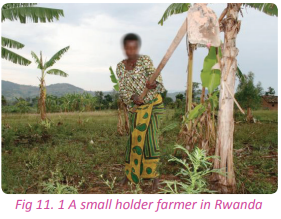 (b) Market gardening
(b) Market gardening
This is a newly introduced form of agriculture.
In Rwanda, it is practiced in areas that are
near urban centres. It involves the growing
of crops in areas where there is great
demand for the products
Crops grown under market gardening in
Rwanda include the following.
• Vegetables
• Flowers
• Fruits
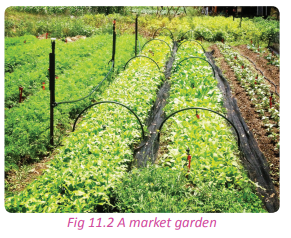
Market gardening is practiced in areas such
as the out-skirts of:
• Kigali City
• Rwamagana
• Musanze
• Rubavu as one
enters the town
from Kigali.
• Nyamata
(c) Horticulture
This is the growing of crops that are highly
perishable.
They therefore need to be
as near the market as possible for quick
consumption. The horticultural crops grown
in Rwanda include the following:
• Tomatoes
• Flowers
• Fruits
• Cabbages
• Spinach
(b) Market gardening
This is a newly introduced form of agriculture.
In Rwanda, it is practiced in areas that are
near urban centres. It involves the growing
of crops in areas where there is great
demand for the products.
Crops grown under market gardening in
Rwanda include the following.
• Vegetables
• Flowers
• Fruits

 Examples of subsistence crops in
Rwanda
Examples of subsistence crops in
Rwanda
Activity 11.5
Work in groups.
Use your local environment.
1. Name the subsistence crops that you
see in your school garden or in your
home area.
2. Give reasons why you think the people
of Rwanda grow the crops listed.
3. Share your findings with your partner.
Rwanda has different types of crops grown
for subsistence. The crops are different
basing on the climate, soils and nature of
relief.
For example:
(a) In the Eastern Province, the crops
grown include:
(i) Bananas, maize, sorghum and
groundnuts in the districts of
Rwamagana, Kayonza, Gatsibo and Ngoma.
(ii) Kirehe is well known for pineapple
growing.
(iii) Cassava in Bugesera
(iv) Rice in Akagera River valleys
(b) In the Northern Province, the crops
grown include: (wheat in Gicumbi,
Burera and Musanze Districts.
(c) In the Southern Province, the crops
grown include; sorghum, cassava, maize
and rice in Nyaruguru and Nyamagabe
Districts.
(d) In the Western Province, the crops
grown include:
(i) Wheat in Nyabihu
(ii) Maize and sorghum in Nyamasheke
Factors for subsistence
farming in Rwanda
Activity 11.6
Work in pairs.
Use your local environment.
1. Explain the factors that favour
subsistence farming in Rwanda.
2. Write down your findings and discuss
them in a class presentation
There are a number of factors that favour
subsistence farming in Rwanda. They
include the following.
(a) The majority of the people of Rwanda
are low income earners. These are
the people who practice subsistence
farming.
(b) There is a shortage of land in Rwanda.
The little land that is available has
been fragmented into small pieces that
cannot support other types of large
scale farming.
(c) The relief of Rwanda discourages other
types of farming.
(d) Inadequate awareness has also
contributed a lot to the persistence of
subsistence farming in Rwanda.
(e) The remote areas of some parts of
Rwanda are so far from modernisation.
This keeps them tied to traditional
methods of farming such as subsistence
farming.
(f) The Rwandan farmers produce similar
crops. This reduces the demand of
the produce thus making them for
subsistence.
(g) Most small-scale farmers in Rwanda
are rigid. They refuse to adapt to new
methods of farming opting to stick to the farming methods of their fore
fathers.
Advantages and disadvantages
of improved subsistence crop
cultivation
Activity 11.7
Work in pairs.
Use the Internet and other sources of
geographical information.
1. Find out the advantages and
disadvantages of improved
subsistence farming.
2. Discuss the points that you have
highlighted relating them to your
local environment.
3. Present them in a class discussion.
Advantages of improved subsistence
farming
(a) It is an appropriate system for sparsely
populated areas such as Nyagatare.
(b) There are less chances of soil erosion
because virgin forests are cleared and
small plots cultivated.
(c) It provides a means of dealing with
weeds.
(d) Soil fertility is maintained since there is
mixed cropping.
(e) The mixing of plants of different heights
provides a good cover for the soil. This
helps to protect the soil from erosion.
(f) This type of farming is cheap to maintain
since it does not involve a lot of capital.
Family labour is used.
(g) There is a continuous supply of food
because the different crops grown on
the piece of land are ready for harvest
at different times.
Disadvantages of improved
subsistence farming
(a) Clearing land in preparation for cultivation
destroys valuable vegetation such as
forests for timber and herbal medicines.
(b) Once vegetation has been cleared, the
nutrient cycle is broken. Organic matter
and bacteria that would help in keeping
the soil fertile are destroyed.
(c) Land is not given enough time for
regeneration. It is over cultivated
season in, season out.
(d) There is low agricultural output due
to the use of simple tools and manual
labour.
(e) The farmers resist modern farming
practices and advice. This leads to little
output of low quality.
(f) The system is not able to keep pace
with the increase in population
since production is mainly for home
consumption.
(g) There is a high risk of the spread of pests
and diseases to the crops. This affects
the crop yields.
Activity 11.8
Work in groups of five.
Improved farming methods lead to food
security in the country.
1. Visit the farmers who practice
subsistence farming in the areas near
your school.
2. Observe their farming methods and
suggest ways in which they can improve
their farming and hence outputs.
3. Advise the farmers in the area near your
school and home on how to improve
their farming methods.
4. Write a report and share it with your classmates and also with the farmers
you visited.
Task 11.1
1. Differentiate between horticulture and
market gardening.
2. Discuss the reason behind the
widespread practice of subsistence
farming in the country.
3. Explain why subsistence farming is
important to the country’s economy.
Plantation farming
Activity 11.9
Work in pairs.
Use the Internet, dictionary and other
geographical documents.
1. Define plantation farming.
2. Share the findings of your discussion
with other class members.
Plantation farming or plantation agriculture
is a form of commercial farming where crops
are grown for profit. Large land areas are
needed for this type of farming. Crops grown
in plantation farming are mostly cash crops.
Major plantation crops and
areas where they are grown
Activity 11.10
Work in pairs.
1. Name the crops that are grown in
plantations in Rwanda.
2. Identify the areas where the crops
named are cultivated.
3. Discuss them in a class presentation.
The crops grown in plantation farming in
Rwanda are cash crops. They include the
following:
(a) Coffee
This is one of the most successfully grown
cash crops in Rwanda. It holds the second
position of Rwanda’s exports after tea. It
is grown in small farms throughout the
country as opposed to large plantations.
Coffee was first grown in Rwanda in 1902.
Later on, it was successfully grown in
Kabgayi in1907. In 1930 Arabica coffee was
introduced to the whole country.
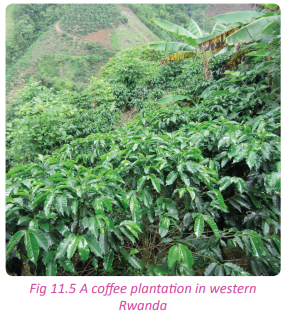
(b) Tea
This crop was introduced much later than
coffee. During the colonial times it was
grown on two private farms of Gicumbi and
Rulindo. Today, tea is grown at Gisakura,
Shagasha,Pfunda,Mulindi,Nyabihu,Mata,
Kitabi and Gisovu. Tea accounts for about
20% of Rwanda’s exports.

(c) Pyrethrum
This crop was introduced to the Volcanoes
Park neighbourhood at between altitudes
2200m and 2700m above sea level. This
crop is grown in Nyabihu, Musanze, Rubavu
and Burera districts.
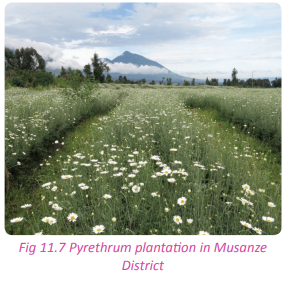
Characteristics of plantation
farming
Activity 11.11
Work in groups.
Your teacher will organise for you to visit
one of the plantation farms in the country.
While on the visit;
1. Identify the characteristics of the
plantation crop in the farm that you
have visited.
2. Relate the characteristics identified to
other plantation crops and farms in the
country.
3. Write a report on your findings and
present it in a class discussion.
Some of the characteristics of plantation
farming in Rwanda include the following:
(a) Crops are grown on a large-scale usually
covering thousands of hectares of land.
(b) One or two crops are grown in the farms.
(c) A huge labour force is required
comprising of skilled, semi-skilled and
unskilled workers.
(d) Plantation farming requires heavy capital
investment to purchase machinery and
establish infrastructure.
(e) Production is mainly for the market and
not for the farmers’ consumption.
(f) Most of the plantation farms are owned
by the government, foreigners or
cooperative societies which have the
capital required to inject in the business.
(g) The plantations are scientifically
managed. They use machineries,
fertilisers, hybrid seeds and irrigation
by pipes and overhead sprinklers.
 The crops are planted in neat rows.
The crops are planted in neat rows.
(i) The plantation farms have welldeveloped networks of transport
connecting plantation areas, processing
industries and markets.
(j) There is specialisation of labour since
in the farms workers are assigned
specific tasks.
Factors favouring plantation
agriculture in Rwanda
Activity 11.12
Work in groups.
Under the guidance of your teacher, visit a
plantation farm in the country. In groups of
five;
1. Find out the factors that favour the
plantation farming of the crop.
2. Relate the factors identified to other
plantation farms in the country.
3. Write them down and discuss them in
a class presentation.
There are physical and human factors that
favour plantation farming in the country.
They are discussed below.
Physical factors
(a) The presence of heavy and reliable
rainfall throughout the year.
(b) The presence of moderate temperatures
that favour ripening of crops for easy
harvesting.
(c) The existence of deep, fertile and well
drained soils which favour the growth
of perennial crops such as coffee, sugar
cane, tea.
(d) Relief: The presence of vast and
extensive land which slopes gently
enabling mechanisation of the farms.
(e) Areas where plantation farming takes
place are free from pests and diseases.
Human factors
(a) Improved transport and communication
networks linking up different areas.
(b) Improved technology manifested by the
use of advanced machines, fertilisers
and irrigation.
(c) Presence of capital provided by foreigners,
governments and cooperatives which is
used to pay workers or purchase the
input.
(d) Supportive government policies such
as allowing foreign investors to invest
in plantation farming, construction of
transport routes connecting plantations
to market areas and tax holidays.
(e) Existence of large pieces of flat lands
that are 100 hectares and above which
enable large scale growing of crops and
use of machines.
(f) Availability of capital to buy machines,
cater for workers and buy other farm
inputs such as fertilisers.
(g) Presence of both skilled and semi-skilled
workers who provide labour that is used
in the farms.
 Existence of good transport and
communication systems to transport the
produce from plantations to processing
centres, products to market centres.
Existence of good transport and
communication systems to transport the
produce from plantations to processing
centres, products to market centres.
(i) Large markets both at the local and
international levels to consume products
from plantations.
Advantages and disadvantages of
plantation farming
Activity 11.13
In a field visit to one of the plantation farms,
find out the following from a resource
person. Work in groups of five:
1. The advantages of plantation
agriculture.
2. The disadvantages of plantation
agriculture.
3. Write down a report of your findings
and present them in a class discussion.
Advantages of plantation
farming
There are various advantages of plantation
farming in Rwanda. They include the following:
(a) Plantation farming has led to the
development of industries.
(b) Plantation farming has promoted
agricultural research which has
improved quality of the produce.
(c) Plantation farming has provided
employment opportunities to the
citizens of Rwanda.
(d) Plantation farming is a source of
government revenue through taxes,
fines and exports.
(e) It has led to self reliance. The country
has export products that it depends on.
(f) Plantation farming promotes export,
bilateral and multilateral trade in cash
crops.
(g) It has helped in the development of the
rural areas through the construction of
feeder roads.
 The government earns foreign exchange
through exports.
The government earns foreign exchange
through exports.
(i) It has helped to foster international
relationships with other countries
through international trade.
(j) Plantation farming supports research
and study.
Disadvantages of plantation
farming
(a) The cultivation of one type of crop
exhausts the soils reducing their fertility
and therefore productivity.
(b) The agricultural produce such as coffee
and tea are subject to price fluctuations.
This leads to severe losses when the
prices go down.
(c) The plantations are greatly affected by
the changes in the weather conditions
such as too much rainfall, strong winds
or sometimes drought.
(d) Diseases and pests spread very fast in
plantations. Once one crop is attacked
by a disease or pest, it easily spreads to
the whole plantation.
(e) Most plantations are owned by foreigners.
This leads to profit repatriation. The
country does not therefore benefit from
the farms.
(f) It leads to shortage of food crops since
the crops produced are cash crops.
(g) It encourages rural-rural migration
which off balances rural economic
development.
 There is overproduction of the produce
cultivated in plantation farming.
There is overproduction of the produce
cultivated in plantation farming.
(i) There is stiff competition from other
countries that also practice plantation
farming.
(j) The use of machines has replaced
human labour leading to a class of
unemployed people.
(k) Some of the machines that are used in
the processing the crops in plantation
farms have negative effects on the
environment.
Case study
Tea plantation
Activity 11.14
Work in pairs.
Use the Internet and other sources of
geographical information.
1. Find out the specific plantation farms in
Rwanda, the areas where they are found
and the crops that are grown n the farms.
2. Write down your findings and present
them in class.
Kitabi tea plantation
The Kitabi tea plantation is owned by the
Kitabi Tea Company Ltd. that is located
in the Southern Province of the country.
The company has tea plantations, a tea
factory and a firewood forest. It is located
in Nyamagabe district, in the Southern
Province along the northern boundary of
the Nyungwe natural forest. It is situated at
2,300 metres above sea level. The company
is located 5 kilometres away from the main
Nyamagabe road. It is approximately 187
kilometres from Kigali.
Kitabi tea bushes are grown on rich drained
soils. 850 hectares of the land with tea bushes belong to the out grower tea farmers
of the Cobacyamu cooperative and 800
hectares belong to the company.
The firewood forest occupies 540 hectares
of land located in and around the tea
plantations. Natural resources are protected
through agricultural practices that are
friendly. Kitabi Tea Company Ltd. provides a
safe professional working environment to its
employees, focusing on the welfare of the
workers. It also supports the communities
neighbouring tea plantations.
Kitabi Tea Company Ltd. contributes
to alleviating poverty within the local
communities through providing employment
to 5,000 people and periodically distributing
cows to the most vulnerable households.
It has also assisted in the construction of
a vocational school to equip children with
life skills.
Kitabi Tea Company Ltd has products like:
• Green tea which is produced at the
Kitabi Tea Company Ltd. This is mostly
available in blended and packaged
forms. Rwanda Mountain Tea has
majority shares in the tea blending
company.
• Black tea which is also produced by the
Rwanda Mountain Tea Ltd. company.
The company produces some of the
best black tea in Central and Eastern
Africa. This black tea produces a dark
coppery brew with rich, full-bodied
flavours. Most of these tea types are
offered for sale at the Mombasa market
in Kenya.
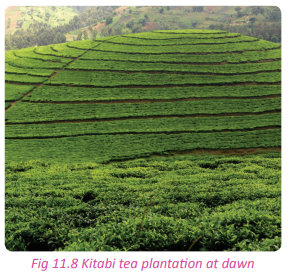
Sugarcane
plantation
Kabuye / Nyacyonga, Nyabarongo valley
Estates
Kabuye/Nyacyonga, and Nyabarongo valley
are sugarcane estates that are owned by
the Kabuye Sugar Works. It is the sole sugar
company in the country. The company
produces about 30% of the sugar market
supply. The company is owned by the
Madhvani group, a Ugandan based firm.
The processing factory gets sugarcane from
its plantations at Nyacyonga and Nyabarongo
valleys. The sugarcane is grown on the
swampy soils. This has always affected the
production of sugar during the rainy seasons
when the floods affect the estates, destroying
hundreds of hectares of sugar plantations.
Sugarcane production from these fields is
supplemented by sugarcane that is bought
from the outgrowers, who still use the
reclaimed swampy areas to plant their
sigarcane. The company is supported by
Ministry of Agriculture and Animal Resources,
which has introduced agricultural extension
services that assist the sugarcane growers
by providing them with high yielding, quick
maturing and disease resistant varieties of
sugarcane.
There is a campaign run by the management
of Kabuye Sugar Works to encourage upland
cultivation in order to increase sugarcane
production. The company is now expanding
the sugarcane estates in a joint operation
with the Dutch Government under the
Nyabugongo land reclamation project. In
this project, 200 hectares of land are being
prepared and planted.
The Kabuye Sugar Works has the capacity
of producing 60,000 tonnes of sugar but
only produces 10,000 tonnes due to limited
supply of sugarcane.
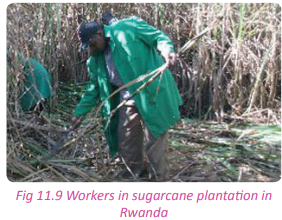
Task 11.2
1. Is plantation agriculture necessary in Rwanda? Discuss.
2. Analyse the challenges faced by plantation agriculture in the country.
3. Suggest ways in which plantation agriculture can be improved in Rwanda.
Agriculture modernisation in Rwanda
Activity 11.15
Work in pairs.
Study the photographs shown below and answer the questions that follow.
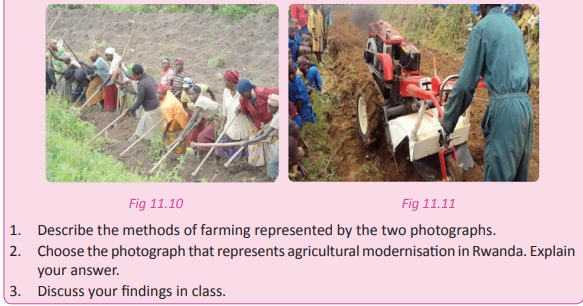
Definition
Agricultural modernisation is the process of
transforming the agricultural sector into one
that is dynamic, technologically advanced
and competitive yet centred on human
resource development and guided by the
sound principles of social justice. This is
meant to increase yields.
Agricultural modernisation is not only tied
down to the use of machines but deals
with the use of any improved methods of
farming that enable farmers to increase
their produce.
Factors for modernisation of
agriculture
Activity 11.16
Work in groups of three.
Use the Internet and your local environment.
1. Find out and explain the factors that
influence modernisation of agriculture
in Rwanda.
2. Write down the factors and discuss
them in a class presentation.
Factors that enable agricultural modernisation
in the country include the following
(a) The availability of capital that is essential
in the purchase of modern equipment,
improved seed varieties, hiring skilled
labour, research and meeting the cost
of implementation.
b) Supportive government policies on
land reforms. This avails more land for
modern agricultural practices.
(c) Use of research findings and scientific
discoveries in agricultural activities.
(d) Education on modern methods of
agriculture both in crop cultivation and
animal husbandry.
(e) Partners from foreign, developed
countries and finance institutions
who are ready to help turn around
agricultural activities in the country.
(f) Commercialisation of agriculture which
makes farmers willing to embrace
modernisation so as to increase their
yields and thus profits.
(g) Improved technological advancement
in the country that manifests itself
through the use of improved farming
methods such as irrigation farming.
 Availability of skilled labour in the
modernisation of agricultural practices.
Availability of skilled labour in the
modernisation of agricultural practices.
Activity 11.17
Work in pairs.
Study the photographs provided below and use them to answer the questions that follow.
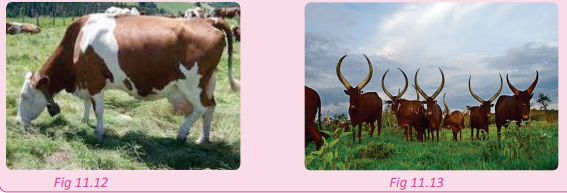
1. Describe the types of cattle breeds that are shown in the photographs.
2. Which of the cattle breeds is as a result of modernisation of agriculture?
3. Give reasons for your answer in (2) above.
4. Write down your findings and present them in a class discussion.
Methods used to modernise
agriculture
Activity 11.18
Work in pairs.
Use the Internet and your local environment.
1. Find out and discuss the methods used
to modernise agriculture in Rwanda.
2. Write them down and present them in
a class discussion.
Some of the ways through which agriculture
is modernised include the following.
(a) Use of irrigation.
(b) Use of hybrid seeds.
(c) Use of artificial insemination.
(d) Use of improved farm tools and
machines in the farming practices such
as for planting, weeding and harvesting.
(e) Use of chemical fertilisers.
(f) Training farmers.
(g) Use of improved methods of crop
cultivation such as terracing, mulching,
use of contours, strip cultivation,
agroforestry, etc .
 Land consolidation in order to increase
the cultivatable land and yields.
Land consolidation in order to increase
the cultivatable land and yields.
(i) Improved weed control measures such
as spraying herbicides and the use of
integrated weed control methods.
(j) Preparation of seeds before storage.
(k) Use of improved storage facilities for
agricultural produce such as use of silos
to store maize.
Problems limiting agriculture
modernisation in Rwanda
Activity 11.19
Work in groups of three.
Use your local environment.
1. Discuss the problems hindering
agricultural modernisation in Rwanda.
2. Write them down and discuss them in
a class presentation.
There are various challenges that affect
agricultural modernisation in Rwanda.They
include the following.
(a)
Limited capital: Most farmers in Rwanda
are poor. They do not have enough
capital to buy farm machinery, pay
workers and to improve their facilities.
(b)
Unfavourable topography: Most
areas in Rwanda have steep slopes
with rugged terrain. This limits
m e c h a n i s a t i o n o f a g r i c u l t u re
because the areas are inaccessible.
(c)
Unfavourable climatic conditions: Areas
such as the Eastern Province have little
rainfall. This limits the water volumes in
the rivers thus less water for irrigation.
This limits agricultural modernisation.
(d)
Limited skilled labour: Rwanda has
low levels of skilled manpower to
improve agriculture. Most rural
farmers are still illiterate and have not
embraced modernisation of agriculture.
(e)
Poor storage facilities: The storage
facilities used in the country are fairly
archaic. This affects yields of crops
such as maize and beans which are
frequently attacked by weevils. It is also
a challenge to store perishable produce
like cabbages, tomatoes and carrots.
(f)
Unfavourable land tenure system: Some
people own very big plots of land while
others have small plots of land. There
is also too much land fragmentation.
The land has been subdivided
into very small pieces that cannot
support modernisation of agriculture.
(g)
Poor soils: Some areas in Rwanda
such as areas of Umutara and Ngoma
in the Southern Province, have sandy
soils. These soils are a problem to
modernisation of agriculture.
 Population increase
Population increase: Population
growth increases pressure on land.
This pressure creates competition
between the need for settlement and
modernisation of agricultural practices.
(i)
Poor uptake of technology and slow
technological advancements: Most
farmers in Rwanda still use traditional
methods of farming. They use simple tools
like pangas and hoes. This is a problem
to the efforts to modernise agriculture.
(j)
Limited markets: Many Rwandans
a r e u n e m p l o y e d l o w i n c o m e
earners. There is therefore no local
market for the high yields realised
from modernisation of agriculture.
(k)
Inaccessibility of some parts of the
country: Most farms in Rwanda are
located in the rural areas where there
are no transport facilities. It therefore
becomes very difficult to modernise
agriculture in such remote areas.
(i)
Low financial capability: The farm
in-puts in Rwanda are expensive.
Since a majority of the Rwandans
are peasant farmers who cannot
afford them. This is a drawback to
the modernisation of agriculture.
Ways of improving agricultural
production in Rwanda
Activity 11.20 Work in pairs.
Use your local environment and the Internet;
1. Research and suggest ways of improving
agricultural production in the country.
2. Write down your findings and discuss
them in a class presentation.
Some of the ways in which agriculture
in Rwanda can be improved include the
following.
(a) Organising farmers into farming
cooperatives so that they are able to
cultivate land on a large-scale.
(b) Provision of improved seed varieties
that have a short maturity period and
high yielding capacity.
(c) Cross breeding the local breeds with
the exotic ones so as to have improved
breeds.
(d) Establishment of large scale irrigation
schemes based on co-operative farming.
(e) Encouraging the farmers to use improved
methods of farming to reduce wastage
of resources.
(f) Extending credit schemes to the rural
farmers through Saccos such as the
Umurenge SACCO.
(g) Mass education programs given to
farmers with an aim of equipping them
with the agricultural modernisation
techniques.

Use of both artificial fertilisers and
organic manures to improve productivity
in the smaller farms.
(i) The government should increase its
provision of farm inputs and machineries
such as tractors that can be affordably
accessed by famers through saccos.
(j) Establishment of storage facilities in
every sector so that seeds to be planted
in the next season are preserved.
(k) More demonstration and agricultural
research centres should established to
enable more research.
(l) Implementation of land reform programs
so that people are resettled in specific
areas so that more land is created for
agricultural activities.
Livestock farming
Activity 11.21
Work in pairs.
Use the Internet, a dictionary and your local
environment.
1. Define livestock farming.
2. Name the livestock that are reared in
Rwanda.
3. Discuss this in class.
Livestock farming is the rearing of
domesticated animals such as cattle, sheep,
goats and pigs for food (milk or meat),
fibre and labour. The people of Rwanda
are well- known for animal keeping. Animal
keeping is part of the Rwandan culture. The
animals are reared for both subsistence and
commercial purposes.
Livestock farming in Rwanda is divided into
two types.
1. Traditional livestock farming
2. Modern livestock farming
Definition of ranching
Activity 11.22
Work in pairs.
Use the Internet, dictionary and other
sources of geographical information;
1. Define the following terms:
(a) Ranching
(b) Dairying
(c) Zero grazing
2. Discuss the meanings in a class
presentation.
Ranching is the practice of raising or grazing
livestock such as cattle or sheep for meat,
wool or skin and hides in large tracts of land.
Ranching in the livestock industry is growing
faster than any other agricultural sector in
the world. The animals reared in ranches are
usually for commercial purposes
In Rwanda ranches are found in Bugesera,
Nyagatare, Gatsibo and Ngoma areas. There
are also ranches found in other parts of the
country on a small scale. Animals reared on
ranches include: Ankole, Jersey, Friesian,
Brown Swiss and Sahiwal breeds of cattle.
Ankole is the local breed of cattle that has
long horns.
Definition of dairying
Dairying refers to the business of producing,
storing and distributing milk and its products.
In dairy farming, livestock are reared for
milk production for both subsistence and
commercial purposes. Breeds of cattle kept
for dairy farming include Friesian and Jersey
Definition of zero grazing
Zero grazing is farming method that involves
keeping cows inside enclosed shelters
feeding them and rather than letting them
feed in the fields. Zero-grazing is a good
system of keeping dairy cattle in densely
populated areas, where land is small. Dairy
farmers sometimes zero graze their cattle.
Characteristics of ranching Below are the characteristics of ranching.
(a) The animals kept are both for beef and
milk production.
(b) Improved breeds of sheep, goats and
cattle are kept.
(c) Animals are reared on land individually
owned or under cooperative units.
(d) Animals are kept for commercial
purposes i.e. to earn income.
(e) The movement of animals is confined
to the
paddock within the ranch.
(f) There is grazing on both natural and
artificial pastures, for example Alfalfa.
(g) Exotic breeds, cross breeds and local
breeds are all kept together.

Ranches are scientifically managed and
there is use of artificial insemination,
food mixers, de-worming, de-horning,
and dipping among other modern
practices.
(i) There is neither overgrazing nor
overstocking in ranches.
(j) A huge capital investment is required
to purchase machinery, pay workers,
fence off the ranches and to maintain
them.
(k) There is constant record keeping of all
inputs and outputs.
Characteristics of dairy farming
in Rwanda
Below are the characteristics of dairy
farming.
(a) Improved breeds of animals are
reared. These have a high milk yielding
capacity.
(b) There are paddocks which are well
facilitated with watering places.
(c) There is a scientific approach towards
animal keeping such as spraying,
vaccination and other veterinary
services.
(d) The local breeds of animals are crossed
with exotic ones and other improved
hybrid animals for quality.
(e) Dairy farms are usually established near the markets since the products are perishable.
(f) The animals are grazed on both natural and sometimes manufactured animal feeds.
(g) The animals are kept on a relatively huge land where the movement of animals is
restricted. They are sometimes zero grazed.
 Types of dairy farming
Types of dairy farming
(a) Extensively grazed dairy farming
This type of dairy farming suits locations
with warmer climates. This is because
cattle spend most of their time outside. The
system needs a moderate amount of rain
and temperatures that are warm enough
to encourage grass to grow for as many
months as possible. Careful management
of pastures ensures a bountiful supply of
fresh food for the cattle. When there is lack
of pasture, farmers use stored or purchased
fodder to make up for the loss of grass.
(b) Pasture-based dairy farmingThis type of farming involves raising cattle
in fields during warm months and housing
them in covered sheds during cold months.
Depending on the location’s climate, cattle
may be in shelters for half of the year or
more. These sheds also provide protective
cover for cattle during periods of unusually
hot weather to avoid heat-stressing the herd.
Pasture-based dairy farming decreases the
need to store large amounts of manure by
recycling it as fertiliser for grass production.
(c) Housed dairy farming
This type of dairy farming involves raising
cattle that spend most of the year in a
controlled space inside a shed. Housed
systems keep cattle in modern sheds. To
ensure maximum comfort for the herd, stalls
are designed with room for movement,
bedding and feeding areas. Feed consists
of freshly cut grass or silage mixed with
commercial supplements. This is the most
practiced method in the country.
(d) Experimental dairy farming Experimental dairy farming is based on
research improvements in dairy farming.
They use a variety and combination of
farming methods to find the safest and most
economical way to provide dairy foods for
the market. Important research into new
cow diseases, breeding or drought-tolerant
grasses are undertaken in consultation
with local, national and international
universities. Some also provide training for
farmers in new techniques and technology.
Others maintain field staff to visit farms
and promote dairy farming locally and
nationally
Areas of dairy farming Areas where dairy farming is practiced in
the country include;
• Nyanza
• Bugesera
• Huye
• Muhazi
• Nyagatare
• The outskirts of Kigali City.
Factors hindering the
development of dairy farming
Activity 11.23
Your teacher will organise a field visit for
you to visit a dairy farm. In groups of five;
1. Find out the factors that hinder the
development of dairy farming in the
dairy farm that you have visited.
2. Relate these factors to diary farming
in the country.
3. Write down your findings and present
them in a class discussion.
Factors that hinder the development
of dairy farming in Rwanda include the
following.
(a) Poor climatic conditions characterised
by prolonged dry seasons. This leads to
shortage of water and pasture.
(b) The presence of pests and diseases
that claim a large a number of animals
especially the exotic ones.
(c) The dairy farmers in Rwanda still use
poor methods of farming.
(d) There is inadequate market for the dairy
products both locally and regionally.
(e) The dairy farms in Rwanda are located
in rural areas where roads are poor
and impassable especially during the
rainy season. The dairy products end
up getting spoilt.
(f) Most farmers are poor and do not have
enough funds. This has made many
farmers unable to modernise their
operations.
(g) Absence of veterinary services
especially in rural areas.

There are still inadequate modern
storage facilities of dairy products. This
has always made farmers incur losses.
(i) There is competition from imported
milk products such as the condensed
milk from South Africa and Holland.
Ways of improving the livestock
farming in Rwanda
Activity 11.24 Work in groups of five.
Visit livestock farmers in the sector where
your school is found.
1. Identify the problems encountered by
the livestock farmers.
2. Find out ways in which livestock farming
in the country can be improved.
3. Write a report on your findings and
present them in a class discussion.
Some of the ways through which livestock
farming can be improved include:
(a) Use of improved, modern methods of
farming such as paddocking.
(b) Supplementing natural pasture with
artificial animal feeds.
(c) Extending veterinary services to all
the areas where livestock keeping is
practiced.
(d) Replacing the local breeds of animals
with the exotic to increase the out-put.
Where possible, cross breeding should
be introduced.
(e) Milk processing industries should be
established so that a large market for
the dairy produce can be created.
(f) Pests and diseases should be controlled
through constant spraying. Frequent
checks and monitoring of diseased
animals should be done in order to
isolate the diseased animals in time to
avoid the spread of diseases.
(g) The farmers should be organised into
cooperative societies so that they pool
resources together and be able to
secure credit facilities from financial
institutions.

Several milk collecting centres should
be established near the farmers to
avoid wastage.
(i) Transport facilities should be established
and the existing ones rehabilitated so that the farmers are able to transport
the livestock farm produce as quickly
as possible.
(j) The government should come up
with supportive policies that will
encourage foreign investors to establish
commercial livestock farms in the
country.
Keeping small animals
Activity 11.25
Work in pairs.
Use the Internet and other geographical
sources of information.
1. Identify the types of small animals that
are reared in Rwanda.
2. Give the importance of the small
animals that are kept by farmers in the
country.
3. Write your findings in a class discussion.
The keeping of livestock involves the keeping
of animals such as rabbits, sheep, goats,
pigs, bees and poultry. These animals are
reared for both domestic and commercial
purposes.
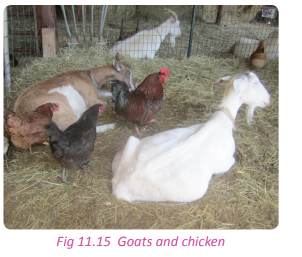

In many parts of Rwanda, small animals are
mainly kept for domestic use. There are
also farmers who keep them in large scale
for commercial purposes. The rearing of
small animals is mostly carried out by small
income earners.
Pig keeping
This is a common activity in Rwanda. Many
households keep pigs. They are kept to
earn farmers income from the sale of their
meat. Pig keeping is done in a small scale.
They are kept in all areas of the country
However, most pig farmers are found in
Huye, Nyaruguru and Nyamagabe districts
in the Southern Province of the country
Poultry keeping
This is the rearing of birds. Poultry keeping
in Rwanda is done on both traditional and
modern scales.
Traditional poultry keeping is the most
practiced form of poultry keeping. Almost
every home in the villages has a chicken.
The poultry are kept for domestic and
commercial purposes.
Modern poultry keeping is done on a
large scale because it is fully commercial.
Different birds are kept for eggs and for
meat.
 Goat and sheep keeping
Goat and sheep keeping
Many households in Rwanda keep goats and
sheep alongside crop growing. However,
this is done on a small scale. Goats and
sheep are mainly kept for their meat.
However, some goats also produce milk.
Most farmers sell their goats and sheep as
a source of income.
The goats and sheep kept can withstand the
local environmental conditions especially
the indigenous breeds.
Goats and sheep are kept almost in all areas
of the country but mostly in Nyamagabe,
Rubavu,Gicumbi, Kayonza and Bugesera.
 Rabbit keeping
Rabbit keeping
Rabbit keeping is also known as
cuniculture.
Rabbits are kept for their meat and skin.
They have a significant potential to improve
the food security of small farmers in
Rwanda.
Rabbits are kept in different parts of the
country. They are kept in areas such as
Munyaga Sector, Rwamagana District in
the Eastern Province of Rwanda. They are
mostly kept by rural communities who lack
employment, capital and land. Rabbits
breed within a very short period of time. It is
easy and cheap to maintain rabbits because
they feed on forage, grass, banana peels and
cabbage leaves.
Apiculture
Apiculture is the keeping of bees for
honey. The honey is sold for consumption.
Although the honey produced can be used
domestically, beekeeping is usually done for commercial purposes.
The keeping of bees has become a common
practice in many areas of Rwanda. Traditional
bee keeping takes place in many areas. It
involves keeping bees in traditional hives
called comb hives. Hollow structures are
used as hives. The hives are made from
locally available materials that are cheap
and easy to find. The honey that is harvested
is processed and consumed locally while
some is also exported. Beekeeping is the
most convenient form of farming because
it does not involve expenses of feeding or
treating diseases. Areas in Rwanda where
beekeeping is common are Gishwati and
other forested areas such as Nyungwe,
Birunga and other areas with many trees.
The use of herbicides and insecticides on
crops affects bees.
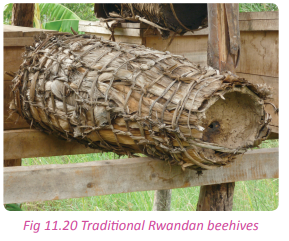 Factors affecting the keeping of
small animals
Activity 11.26
Factors affecting the keeping of
small animals
Activity 11.26
Work in pairs.
Use the Internet and other sources of
geographical information.
1. Find out factors that influence the keeping of small animals in Rwanda.
2. Find out the factors that affect the
keeping of small animals in Rwanda.
3. Write down your findings and present
them in a class discussion
Some of the factors that affect the keeping
of small animals include the following.
(a) Indigenous breeds do not reproduce
quickly. This mostly affects goat breeds.
(b) Traditional grazing methods use the
free range method making the control
of diseases difficult. The quality of feed
is also poor. This mostly affects goat
keeping.
(c) Breeding of the small animals is by
natural methods. This facilitates the
spread of diseases in the animals.
(d) Some communities have cultural
traditions against drinking goat milk,
eating rabbit meat and consuming
other products from the small animals.
(e) Failure to feed the animals well.
nvironment in the country. They easily
get sick and die.

Some animal feeds are expensive to
buy.
(i) Since most of the small animals occupy
small spaces in confinements, it is easy
for them to spread diseases.
(j) The farmers lack capital to modernise
their animal keeping practice.
Methods of improving the
keeping of small animals
Activity 11.27 Your teacher will take you to a field visit to
a farmer who keeps small animals. Observe
the animals and do the following.
Work in
groups of five.
1. Find out the challenges encountered in
the farm.
2. Suggest methods which small animal
farmers in Rwanda can use to improve
their yields.
3. Write a report on your findings and
suggestions and present them in a class
discussion.
Some of the methods of improving the
keeping of small animals include the
following.
(a) Crossbreeding of the animals to create
better and improved breeds.
(b) Feeding the animals on well balanced
feeds to supplement the pasture.
(c) Regular inspection of the animals by
qualified veterinary doctors.
(d) Isolation of diseased animals to avoid
the spread of diseases.
(e) Ensuring that the size of the flock
corresponds to the carrying capacity of
the shed where the animals are kept.
(f) Purchasing the animals or birds to be
reared from reliable, controlled and
registered sources.
(g) Construction of well-ventilated sheds
to avoid suffocation of the animals.

Constant cleaning of the places where
the animals are kept.
Importance of keeping
small animals
Activity 11.28 Work in groups of three.
Visit a farmer who keeps small animals
within your local environment.
1. Find out the importance of keeping
specific small animals to the farmers
and to the country.
2. Write down your findings and present
them in a class discussion.
The rearing of small animals is important in
the following ways.
(a) The animals are a source of income to
the poor.
(b) The animals lead to economic
development through trade between
rural and urban areas.
(c) The keeping of small animals leads to
small scale industrial development like
meat canning in urban centres.
(d) Keeping of small animals helps to
diversify the sources of income in the
home thus reducing dependence on
crop farming.
(e) Smaller animals improve the quality of
life of the poor people in the rural areas
through improved nutrition.
(f) There is a steady supply of organic
manure that is rich with nutrients.
3. Feed the animals well, clean the animal
shed and vaccinate them.
4. Sell their produce to your school and to
the market outside.
Problems affecting livestock in
Rwanda and their solutions
Activity 11.29 With the help of your Geography teacher,
prepare for a fieldwork study to a farm that
keeps livestock.
1. Study and find out the problems that
affect livestock in the farm.
2. Relate these problems to livestock in
the country.
3. Suggest the solutions to the problems
affecting livestock in Rwanda.
4. Write down your findings and present
them in a class presentation.
Some of the problems that affect livestock
in Rwanda include the following.
(a) Harsh climatic conditions especially
during the dry seasons when the
pasture dries up, wells and springs
disappear.
(b) Inadequate capital to modernise
livestock keeping.
(c) Lack of sufficient markets for the
products from the livestock.
(d) Shortage of supply of skilled labour
that is required in the modernisation
of livestock farming.
(e) Poor transport networks and facilities.
(f) Pests and diseases which affect the
animals.
(g) The general lack of pasture has affected
livestock farming in Rwanda.

Livestock are attacked by wild animals
such as leopards and lions in areas that
are near forest.
(i) There is overstocking of animals in some
farms leading to severe soil erosion.
(j) Lack of veterinary services and facilities
in some areas of the country.
(k) There is stiff competition from other
countries such as Uganda, Kenya and
European countries which also practice
livestock keeping and process products.
(l) The farmers still keep indigenous
animals whose productivity is very poor.
Solutions to the problems
affecting livestock in Rwanda
In spite of the fact that livestock farming
in the country faces problems, there are
solutions that are put in place to address
them. They include the following.
(a) The farmers are getting credits from the
financial institutions to finance their
farming activities.
(b) Farmers have organised themselves
into cooperative societies to market
their produce within the country and
in the region.
(c) The farmers have embraced cross
breeding and artificial insemination in
order to have the best breeds of cattle.
(d) The government uses skilled labour
from other neighbouring countries.
(e) The movement of animals should be
restricted and paddocking emphasised.
(f) Animals should be supplied with
commercial feeds to supplement the
natural pastures.
(g) There should be rehabilitation and
construction of roads especially the feeder roads that serve the rural areas.

The farmers should plant fodder crops
and pasture to ensure a constant supply
of pasture throughout the year.
(i) Farmers should take disease prevention
measures to protect the animals.
(j) Agro-based industries should be
established to add value to the livestock
products and to create market for the
products.
(k) Farmers should be educated on matters
concerning livestock farming.
Activity 11.30 Use the Internet and your local environment.
1. Examine the economic contribution of
livestock farming in Rwanda.
2. Analyse the problems associated with
livestock farming to the country.
3. Write down your findings and present
them in a class discussion.
There are important contributions of
livestock farming to the economy of
Rwanda. They include the following.
(a) Livestock farming has created
employment to many people in the
country.
(b) Livestock farming provides tha citizens
of Rwanda with food in the form of
milk, meat, fish, pork, ghee and butter.
(c) The livestock farm owners pay taxes to
the government. The revenue collected
is used to cater for the socio-economic
development of the country.
(d) Some of the products from livestock
farms are exported. The exports earn
the country foreign exchange.
(e) There are many industries that have
been set up that entirely depend on
the livestock farms as a source of raw
materials.
(f) Farmers get profits from the sale of
products from their livestock. This
improves their standards of living.
(g) There has been development of various
infrastructure ranging from transport
networks to industrial and collecting
centres.

Some of the animals such as the royal
long horned traditional cows of Rwanda
commonly known as the Inyambo
attract tourists.
(i) Livestock farming has contributed
a lot to the preservation of some
aspects of the Rwandan culture. This
is expressed in the payment of dowry
and strengthening of friendships as a
sign of brotherhood.
The importance of agriculture to
the economy of Rwanda
Activity 11.31
Work in groups of three.
Use your local environment.
1. Were it not have been for agriculture,
Rwanda would not be where it is. Justify
the importance of agriculture to the
economy of the country.
2. Write a report on the contribution and
present it in a class presentation.
The following are some of the importances
of agriculture to the economy of Rwanda.
(a) Rwanda’s economy greatly depends
on the export of agricultural crops
especially tea and coffee.
(b) Agriculture is a source of employment
to thousands of the people who make
up the Rwandan population.
(c) There are different agricultural
industries in Rwanda. The agro-based
industries pay taxes to the government.
All these help the country to earn
revenue that is used to develop the
nation.
(d) Agriculture in Rwanda has led to
the development of industries. In
this way, it has contributed to the
industrialisation of the country.
(e) Agriculture has enabled the country
to diversify its economy and reduce its
dependence on tourism and mining.
(f) There has been construction of dams
and valley run-off harvesting centres
which assist the communities by
providing additional water supply to
be used during the dry season and in
other services.
(g) There has been establishments of
research centres in Rwanda. This
has benefitted farmers in finding out
new and improved seed varieties and
other agricultural innovations hence
improved productivity.

Agriculture has contributed a lot to the
establishment of various infrastructure
such as roads which play a great role in
the development of the country.
(i) Agriculture has contributed to the
development of urban centres which
have their own advantages. For example
Muvanze and Rwamagana towns.
Activity 11.32
Do this individually.
Use the Internet, Geography textbooks and
other sources of geographical information.
1. Discuss the relationship between crop
and livestock farming.
2. Write an essay on how they impact each
other.
3. Present your work for assessment by
your teacher.
Task 11.5
1. Differentiate between the following
terms:
(a) Ranching and dairy farming
(b) Livestock farming and the keeping
of small animals.
2. Highlight the problems affecting
livestock in Rwanda.
3. Suggest solutions to the problems
highlighted.
Did you know?
• Agriculture is the foundation of the
Rwandan economy, accounting for onethird of Gross Domestic Product (GDP)
and employing nearly 80% of the labour
force.
• Agricultural productivity in Rwanda
is extremely low. The vast majority of
farmers practice subsistence farming on
small and hilly plots.
• Due to erosion and poor soil fertility
practices, up to half of the country’s land
is severely degraded.
• Modernisation of agriculture is still very
limited.
• Due to low agricultural productivity,
nearly half of all Rwandan agricultural
households experience food insecurity.
• Major export markets of Rwanda’s
agricultural products include China,
Germany, and the United States.
End of unit revision task
1. Give and explain five reasons showing how
the hilly terrain of Rwanda is a problem to
agricultural modernisation.
2. (a) Explain what is meant by commercial
livestock farming in Rwanda.
(b) Describe the challenges faced by the
livestock farmers in Rwanda.
(c) Explain the physical conditions that
favour ranching in Rwanda.
3. Examine the role played by agriculture in
industrial development in Rwanda.
4. (a) What is land consolidation?
(b) Identify and explain factors that have
hindered land use in Rwanda.
5. Coffee and tea are considered to be
industrial crops for the economic
development of Rwanda.
(a) Describe the factors which have
favoured the growing of coffee and
tea in Rwanda.
(b) Analyse the benefits of either coffee
or tea to the people of Rwanda.
(c) Examine the problems faced by
farmers who plant the crop chosen in
(b) above.
6. To what extent have physical factors
been responsible for the development of
plantation farming in Rwanda?
7. Assess the contribution of agricultural
co-operative societies to development of
Rwanda.
8. (a) Describe the main features of
improved subsistence farming in
Rwanda.
(b) Assess the contribution of
small holder farming to the socioeconomic development of Rwanda.
9. Explain the following agricultural concepts:
(a) Market gardening
(b) Subsistence farming
(c) Plantation agriculture
(d) Pastoralism
(e) Ranching
10. (a) Define agricultural modernisation.
(b) Explain the factors that have
favoured the development of
agricultural modernisation in Rwanda.
11. Analyse the challenges that have hindered
the implementation of agricultural
modernisation in Rwanda.
12. Account for low agricultural productivity
in Rwanda.
13. (a) Name the crops grown in Rwanda
under plantation agriculture.
(b) List and explain the characteristics of
plantation agriculture in the Rwandan
context.
14. Distinguish between small animal
farming and ranching in Rwanda.
15. Account for the successful development
of small animal farming in Rwanda.
The crops are planted in neat rows.
Existence of good transport and communication systems to transport the produce from plantations to processing centres, products to market centres.
The government earns foreign exchange through exports.
There is overproduction of the produce cultivated in plantation farming.
Availability of skilled labour in the modernisation of agricultural practices.
Land consolidation in order to increase the cultivatable land and yields.
Population increase: Population growth increases pressure on land. This pressure creates competition between the need for settlement and modernisation of agricultural practices.
Use of both artificial fertilisers and organic manures to improve productivity in the smaller farms.
Ranches are scientifically managed and there is use of artificial insemination, food mixers, de-worming, de-horning, and dipping among other modern practices.
There are still inadequate modern storage facilities of dairy products. This has always made farmers incur losses.
Several milk collecting centres should be established near the farmers to avoid wastage.
Some animal feeds are expensive to buy.
Constant cleaning of the places where the animals are kept.
Livestock are attacked by wild animals such as leopards and lions in areas that are near forest.
The farmers should plant fodder crops and pasture to ensure a constant supply of pasture throughout the year.
Some of the animals such as the royal long horned traditional cows of Rwanda commonly known as the Inyambo attract tourists.
Agriculture has contributed a lot to the establishment of various infrastructure such as roads which play a great role in the development of the country.
